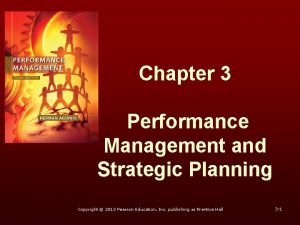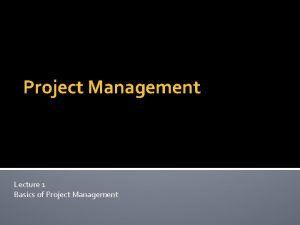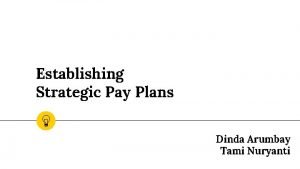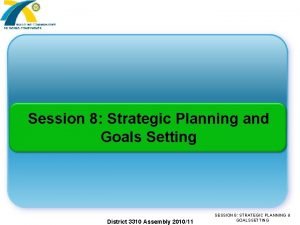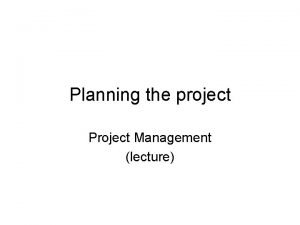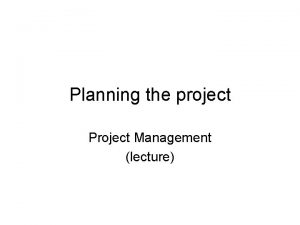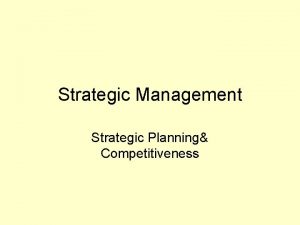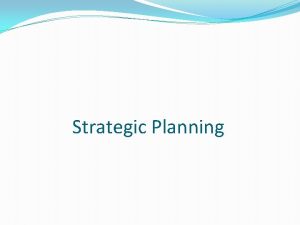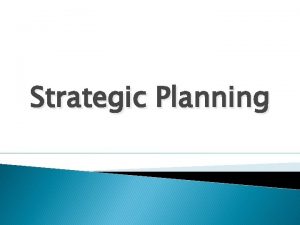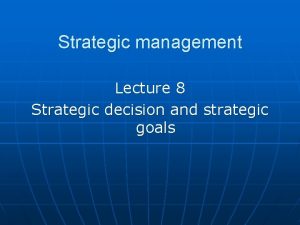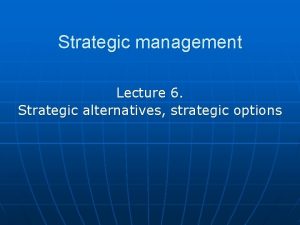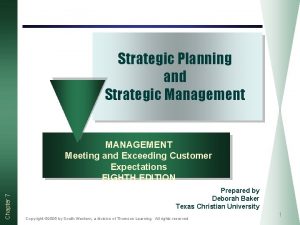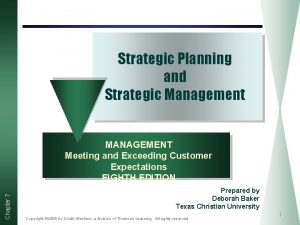Planning the project Project Management lecture Strategic plans




















- Slides: 20

Planning the project Project Management (lecture)

• Strategic plans: – Focus on the big picture – Long term goals (2 -5 years) – „What? ” & „Why? ” • Tactical plans: – Focus on the operations – Short term goals (1 -18 months) – „How? ” Hierarchy of plans Strategic and tactical levels of planning

Strategic and tactical levels of planning • Strategy provides a framework for the tactics. Tactical plans should fit the needs of the strategy. • To permit effective tactical decision making strategy should be: – – Explicit Intelligible (easy to understand) Capable of accepting change Capable of being monitored • Tactical plans on higher levels became strategies for lower levels in the organisation.

Opportunity cost • That which is sacrificed by choosing or failing to adopt a different course of action to that which is currently planned to be taken; = • the value of the next best alternative foregone (that is not chosen).

Elements of project planning 1. Project goals (SOW; top management): 2. 3. 4. 5. 6. 7. 8. Project management plan Work breakdown structure (WBS) Networking (connections of tasks) Responsibility assignment Project schedule (timetable) Budgeting (resources & costs) Risk assessment and risk management Iterative process – Project product specifications, costs, quality, deadlines, project deliverables etc.

Statement of Work (SOW) SOW for the whole project: a detailed narrative description of the work required for a project The effective SOW contains: 1. Introduction and background 2. Technical description 3. Timeline and milestones 4. Client expectations

Statement of Work for the tasks • Describes the activities in the tasks in sufficient detail. • Content: – – – estimated durations resources required costs measures of perfomance (performance indicators) risks and uncertainties reporting procedures

Project deliverable (milestones) • a list of things / activities that need to be delivered to meet the defined goals • when and how each item/activity must be delivered • an estimated delivery date for each item/activity

Detailing the plan • Amount of details included should vary in time. • Short term: fully detailed • The short-term horizon is moving forward (the plan become more-and-more detailed)

Planning techniques in the conception phase (before SOW) • Problem-tree • Objective tree • Logframe matrix

Problem tree diagram A problem tree is a problem analysis tool that illustrates the cause and effect relationship of problems using a hierarchical tree diagram. • by arranging the problem statements in hierarchical order • and depicting the problem statements in a boxed article.

Objective tree • An objective tree is an objective formulation tool that depicts graphically the hierarchy of objectives. It is formulated by initially inverting the statements found in the problem tree (often used in tandem).

Logical Framework Matrix 1. Objectivesstructure 2. Indicators 3. Means of verification 4. Risks and assumptions 1. Startegic goal 2. Immediate objective 3. Outputs (results) 4. Activities (inputs) Pre-conditions

Planning techniques after the SOW • Work Breakdown Structure • Gantt chart • Project Network Techniques (PNTs) – Represent the proposed project as a diagram built up from arrows and nodes – Showing the logic of the project elements – Used to optimize the structure and timing of the work units – Two types: AOA, AON

Project Network Techniques • • Explicit: uncomprimising clarity Intelligible: easy to understand Capable of accepting change Capable of being monitored: easy to feed back the information on performance • But: not an universal problem solving tool

Project Network – Activity on Arrow AOA Locate facilities Order furniture 4 Furniture setup 2 Remodel 1 5 Interview 3 Hire and train Move in 6

Project Network – Activity on Node Order furniture AON Locate facilities Furniture setup 2 6 1 Move in Remodel 5 S Interview 3 Hire and train 4 7

The network as a budget • The financial budget is a quantitative statement prepared prior to a defined period of time, of the policy to be pursued during that period for the purpose of attaining a given objective.

Readings • Lockyer – Gordon (2005) Chapter 4

Thanks for the attention!
 Project planning and management lecture notes ppt
Project planning and management lecture notes ppt Strategic planning process
Strategic planning process Strategic management lecture
Strategic management lecture Strategic planning vs tactical planning
Strategic planning vs tactical planning Resource based model
Resource based model Analysing the 6 strategic options megxit
Analysing the 6 strategic options megxit 01:640:244 lecture notes - lecture 15: plat, idah, farad
01:640:244 lecture notes - lecture 15: plat, idah, farad Strategic planning in retailing
Strategic planning in retailing Performance management and strategic planning
Performance management and strategic planning Project procurement management lecture notes
Project procurement management lecture notes Project management lecture notes doc
Project management lecture notes doc Project management lecture notes doc
Project management lecture notes doc Software cost estimation notes
Software cost estimation notes Project management lecture
Project management lecture Market competitive pay plan adalah
Market competitive pay plan adalah Establishing strategic pay plans
Establishing strategic pay plans Establishing strategic pay plans
Establishing strategic pay plans Job evaluation in hrm
Job evaluation in hrm Strategic vs operational plans
Strategic vs operational plans Establishing strategic pay plans
Establishing strategic pay plans Introduction for project
Introduction for project








